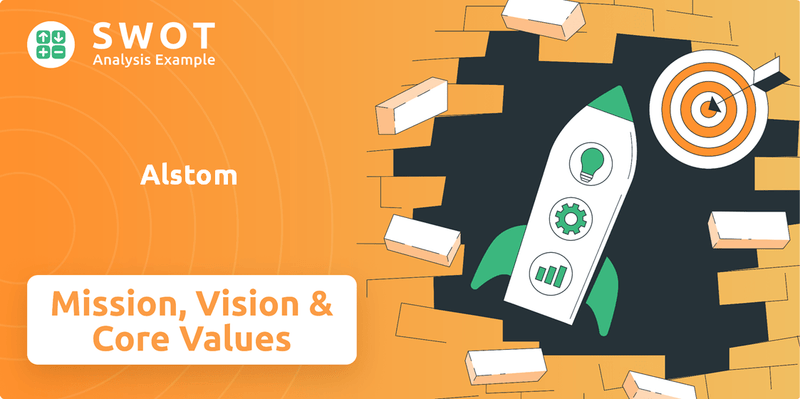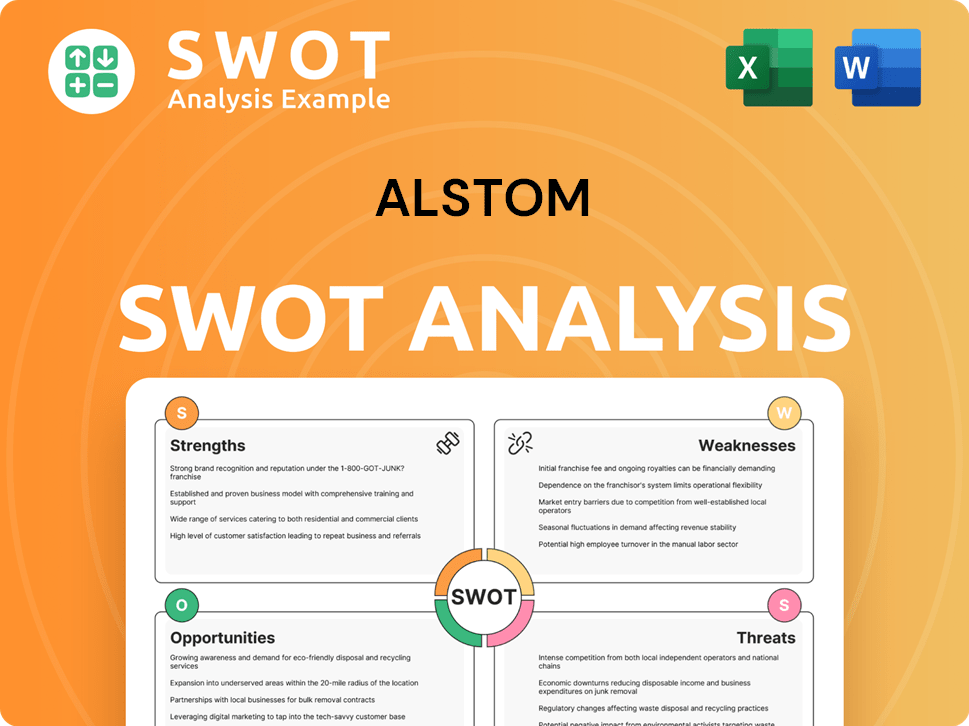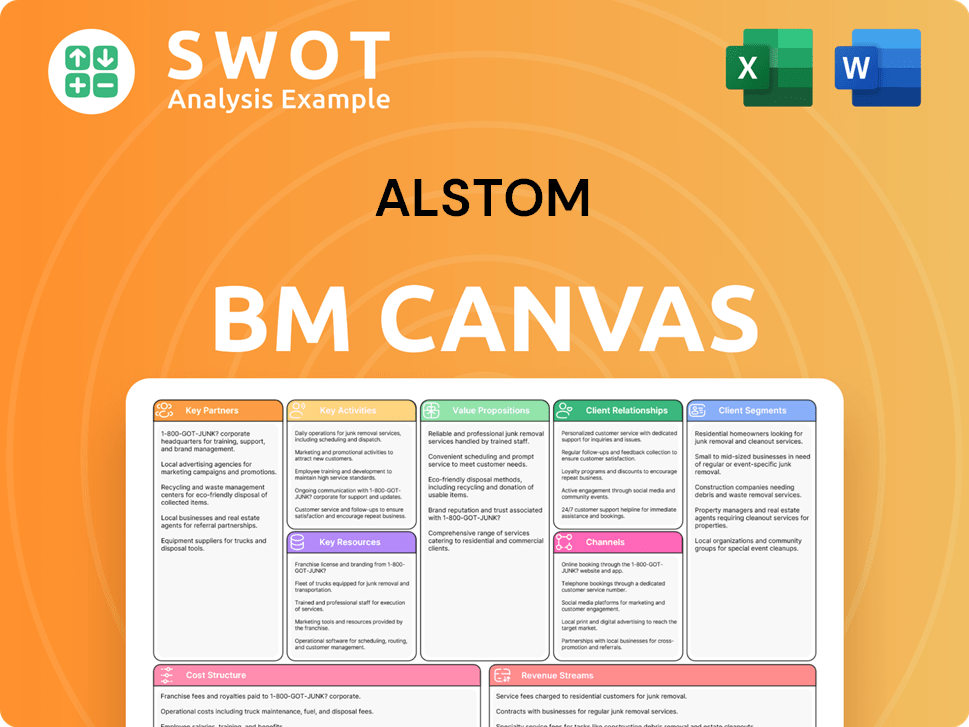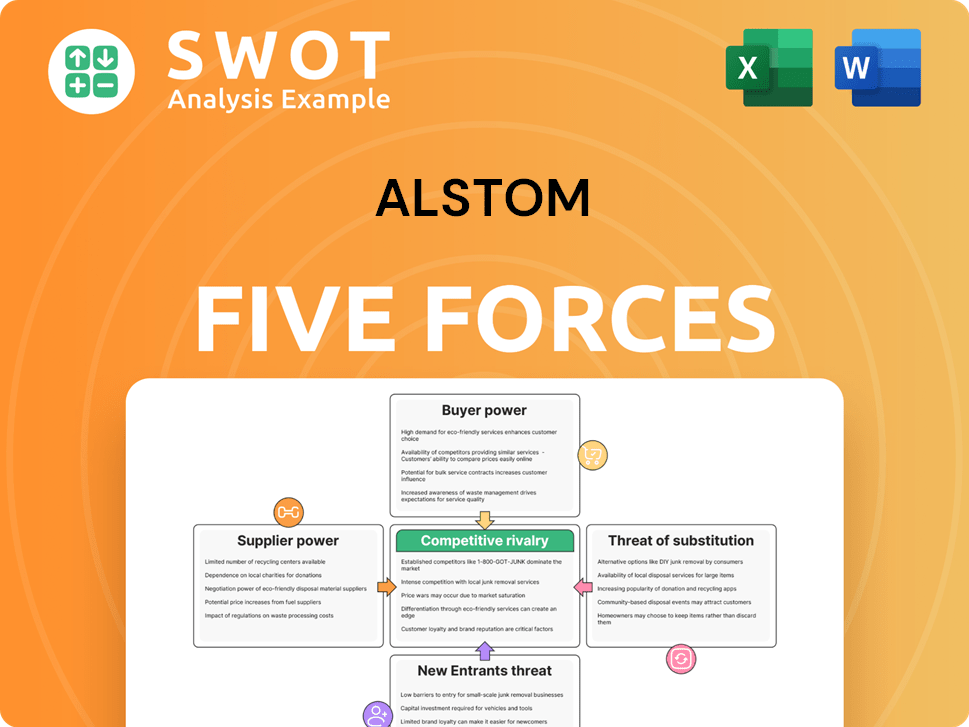Alstom Bundle
What Drives Alstom's Success? Unveiling Its Mission, Vision, and Values!
Every industry leader is guided by a strong foundation. Understanding a company's mission, vision, and core values provides invaluable insights into its strategic direction and operational principles. These elements are crucial for assessing a company's long-term potential and its alignment with your own investment or strategic goals.

Delving into Alstom's Alstom SWOT Analysis reveals the critical importance of its mission, vision, and core values in shaping its identity. These statements are not just corporate jargon; they are the driving force behind Alstom's commitment to innovation, sustainability, and delivering value. Discover how Alstom's mission, vision, and core values influence its strategic objectives and everyday operations, ensuring it remains a key player in the global transportation market and achieves its Alstom Goals.
Key Takeaways
- Alstom's mission, vision, and values drive success in sustainable mobility.
- Innovation and sustainability are key strengths, addressing global needs.
- Commitment to a 'low carbon future' provides a competitive edge.
- Values like integrity and excellence strengthen corporate culture.
- Alignment with principles is crucial for future industry leadership.
Mission: What is Alstom Mission Statement?
Alstom's mission is 'to contribute to a low carbon future by developing and promoting innovative and sustainable transportation solutions that people enjoy riding.'
Let's delve into the core of Alstom's purpose and how it shapes its operations and strategic direction. Understanding the Alstom Mission is crucial for grasping the company's commitment to sustainable mobility and its impact on the global transportation landscape.
The mission statement highlights a strong focus on the end-user experience. Alstom aims to provide transportation solutions that people genuinely enjoy using, emphasizing comfort, efficiency, and overall satisfaction. This customer-centric approach is a key driver of Alstom's innovation and design processes.
Alstom offers a comprehensive range of products and services. This includes high-speed trains, metros, and trams, as well as signaling systems and digital mobility solutions. This diverse portfolio allows Alstom to cater to various transportation needs across different geographies.
With a presence in 63 countries, Alstom operates on a global scale. This extensive reach enables the company to leverage diverse market opportunities and tailor its solutions to meet local requirements. This global footprint is a key aspect of the Alstom Company's strategy.
A core element of Alstom's mission is its dedication to a 'low carbon future.' This commitment drives the development of environmentally friendly transportation solutions, such as hydrogen-powered trains. This focus aligns with the growing global demand for sustainable practices.
Alstom invests heavily in research and development to drive innovation. In the fiscal year 2024/25, R&D spending was approximately €704 million, representing 3.8% of sales. This investment underscores Alstom's commitment to developing cutting-edge technologies for smarter, greener mobility. This is a key component of Alstom's Strategy.
Alstom leverages digital technologies to enhance operational efficiency and improve the overall user experience. For example, digital depots are used to enhance maintenance planning. These digital solutions support Alstom's mission to provide enjoyable and sustainable transportation solutions.
The Alstom Mission is not just a statement; it's a roadmap for the company's actions and investments. It guides the development of innovative, sustainable, and customer-focused transportation solutions. Alstom's dedication to a low-carbon future and its commitment to technological advancement position it as a leader in the global mobility market. For a deeper understanding of Alstom's competitive landscape, consider exploring the Competitors Landscape of Alstom.
Alstom SWOT Analysis
- Complete SWOT Breakdown
- Fully Customizable
- Editable in Excel & Word
- Professional Formatting
- Investor-Ready Format

Vision: What is Alstom Vision Statement?
Alstom's vision is to 'lead the way to greener and smarter mobility, worldwide' and to 'outgrow the rail industry significantly and set new industry standards for smart and green mobility in terms of sustainability, innovation, and profitability' by 2025.
Delving into the core of Alstom's aspirations, its vision transcends mere business objectives, aiming for a fundamental shift in the transportation landscape. This forward-thinking approach is deeply embedded in its strategic plans and operational goals.
The Growth Strategy of Alstom is built upon three key pillars: sustainability, innovation, and profitability. These elements are not just buzzwords but form the core of its operational and strategic decisions. Alstom aims to achieve net-zero carbon emissions by 2030 across its operations.
Alstom's vision extends globally, targeting market leadership in signaling by 2025. This ambitious goal is supported by its extensive installed base of 150,000 vehicles and a workforce of 15,000 service employees. The company's focus on services is a key driver for future growth.
Alstom envisions leveraging advanced technology to improve urban mobility and enhance the passenger experience. Significant investment in research and development (R&D) is crucial to achieving this vision. This commitment to innovation is a cornerstone of its future strategy.
A critical aspect of Alstom's vision is its commitment to environmental responsibility. The company aims to reduce its lifecycle carbon footprint in its products by 20% by 2025. This dedication to sustainability is integral to its long-term strategy.
Alstom's strong financial performance provides a solid base for realizing its ambitious vision. In FY 2024/25, the company reported €19.8 billion in orders, €18.5 billion in sales, and a backlog of €95 billion. This financial stability supports its strategic initiatives.
Alstom's strategic objectives are clearly defined and forward-looking, aiming to set new industry standards. The company's
Alstom's vision, therefore, is a comprehensive roadmap for the future, emphasizing sustainable mobility, technological innovation, and global market leadership. It's a vision underpinned by strong financial performance and a clear commitment to environmental responsibility, positioning Alstom as a key player in the evolving transportation sector.
Alstom PESTLE Analysis
- Covers All 6 PESTLE Categories
- No Research Needed – Save Hours of Work
- Built by Experts, Trusted by Consultants
- Instant Download, Ready to Use
- 100% Editable, Fully Customizable

Values: What is Alstom Core Values Statement?
Understanding the core values of Alstom is crucial to grasping its identity and strategic direction within the global transport sector. These values are not just statements but the guiding principles that shape Alstom's operations, from product development to customer relations, ensuring its commitment to sustainable mobility and innovation.
Innovation is a cornerstone of Alstom's strategy, driving its competitive advantage in the transport sector. Alstom invests heavily in research and development, allocating €704 million (3.8% of sales) in FY 2024/25 to develop smarter and greener mobility solutions, such as hydrogen-powered trains and the 'Digital Rail' program, enhancing operational efficiency by 15%.
Sustainability is at the heart of Alstom's operations, aligning with its goal to support green transportation solutions. In FY 2024/25, Alstom achieved an 8% decrease in Scope 1 and 2 emissions compared to March 2024, with 88% of its electricity consumption sourced from renewables as of March 2025. This commitment is evident in its focus on energy-efficient technologies and a goal of 25% recycled content in new rolling stock.
Integrity is a fundamental value at Alstom, guiding its business practices with the highest ethical standards. This includes transparency, honesty, and accountability, fostering trust with stakeholders and ensuring adherence to all regulatory frameworks. This commitment is crucial for maintaining Alstom's reputation and ensuring long-term success.
Excellence drives Alstom's commitment to delivering high-quality products and services that exceed customer expectations. This is reflected in rigorous testing and homologation processes, such as the Avelia Horizon high-speed trains scheduled for revenue service in early 2026. In addition, Alstom fosters a culture of continuous improvement and high performance.
These core values, which include Innovation, Sustainability, Integrity, and Excellence, are critical to understanding the Alstom's mission. They define Alstom's identity as a leader in sustainable mobility and guide its strategic objectives. To further explore how these values translate into strategic decisions, let's examine how Alstom's mission and vision influence its strategic choices, and how it helps them to define their target market.
How Mission & Vision Influence Alstom Business?
Alstom's Alstom Mission and Alstom Vision serve as the guiding principles for its strategic decisions, directly influencing its actions and investments. These statements provide a framework for the company's long-term goals and operational strategies.
Alstom's commitment to innovation and sustainability is evident in its substantial investment in Research and Development (R&D). This strategic focus directly supports its mission to contribute to a low-carbon future.
- In FY 2024/25, Alstom invested €704 million in R&D, representing 3.8% of sales.
- This investment aims to develop smarter and greener mobility solutions.
- A key metric of success is the 25.7% reduction in energy consumption of Alstom's solutions compared to 2014, exceeding its 2025 target.
Alstom's focus on sustainable mobility significantly shapes its product development and market expansion strategies. The company prioritizes solutions that reduce carbon emissions and promote environmental sustainability.
A prime example of this strategic pivot is Alstom's investment in hydrogen-powered trains. This initiative directly addresses the mission of contributing to a low-carbon future by offering sustainable transportation alternatives.
Alstom's strategic decisions also involve strengthening its presence in key geographies and product lines, particularly in Services and Signalling. These efforts are driven by the Alstom Vision to be a market leader.
In FY 2024/25, Services sales increased by 5.2% on a reported basis and 6.2% organically, demonstrating the effectiveness of this strategy. Strong growth in Signalling orders further supports this strategic direction.
Alstom's response to industry challenges, such as supply chain disruptions, is also shaped by its mission and vision. The company focuses on improving project execution and optimizing industrial efficiency to mitigate disruptions.
Alstom's strong backlog of €95 billion as of March 31, 2025, provides significant visibility on future sales and underscores the alignment of strategic decisions with long-term planning. This robust backlog reflects the company's ability to deliver on its commitments.
In conclusion, Alstom's Alstom Strategy is deeply rooted in its mission and vision, guiding its investments, product development, and operational strategies. To further understand how Alstom generates revenue and structures its business, you can explore the insights provided in Revenue Streams & Business Model of Alstom. Continue to the next chapter to learn about the core improvements to the company's mission and vision.
Alstom Business Model Canvas
- Complete 9-Block Business Model Canvas
- Effortlessly Communicate Your Business Strategy
- Investor-Ready BMC Format
- 100% Editable and Customizable
- Clear and Structured Layout

What Are Mission & Vision Improvements?
While Alstom's foundational statements are strong, strategic enhancements could further solidify its market position and responsiveness to evolving global trends. These refinements would ensure Alstom remains at the forefront of the rail and mobility sectors.
To enhance its Alstom Mission, the company should explicitly detail its commitment to leading in rail digitalization beyond simply offering 'digital mobility solutions'. This includes emphasizing AI, IoT, and big data integration, aligning with the increasing importance of these technologies in the transportation sector. This will help Alstom Company stand out from competitors.
Alstom's Vision could be strengthened by articulating specific, measurable goals for global market share growth, particularly in rapidly developing regions. This would provide tangible growth targets and demonstrate a clear strategic focus. For example, Alstom's investment of over €115 million in Poland from 2022 to 2027 could be directly linked to a specific market share ambition in Europe, enhancing its Alstom Strategy.
The company's sustainability focus could be enhanced by explicitly incorporating circular economy principles and resource efficiency into its Mission and Vision. This includes mentioning the use of recycled materials, like its expanded agreement with SSAB for green steel, to demonstrate a commitment to holistic environmental impact. This would resonate with stakeholders increasingly focused on sustainable practices, reinforcing the Alstom Core Values.
Alstom could improve its mission and vision by increasing transparency in its sustainability reporting and stakeholder engagement. This will help stakeholders understand the company's commitment to environmental, social, and governance (ESG) factors. For more information on the company's financial performance, consider reviewing the insights provided by Owners & Shareholders of Alstom.
How Does Alstom Implement Corporate Strategy?
The successful implementation of a company's mission, vision, and core values is crucial for achieving its strategic objectives and fostering a strong organizational culture. Alstom, a global leader in sustainable mobility, demonstrates this through its actions, communications, and strategic initiatives.
Alstom's mission, focused on providing innovative and sustainable mobility solutions, is evident in its tangible projects and strategic initiatives. The company actively pursues projects that align with its mission to create a greener future. These initiatives are not just statements; they are integral to Alstom's operational and strategic plans, influencing its product development, market positioning, and overall business performance.
- Hydrogen-Powered Trains: The development and deployment of hydrogen-powered trains in countries like Germany, France, and Italy directly reflect Alstom's commitment to 'greener mobility' and a 'low carbon future.' This aligns with its mission to provide sustainable transport solutions.
- Digital Rail Program: Alstom's 'Digital Rail' program, integrating IoT technologies, exemplifies its pursuit of 'smarter mobility' by improving operational efficiency and reducing maintenance costs. This supports the vision to leverage advanced technology for enhanced urban mobility.
- Sustainable Solutions: Alstom's focus on eco-friendly solutions is underscored by its ESG 2025 targets, aiming for carbon neutrality in transport. The company is investing heavily in research and development to create more sustainable products and services.
- Project Examples: Alstom's mission impacts its projects, for example, the company secured a contract worth approximately €150 million in May 2024, to supply 24 electric trains to the Netherlands, further demonstrating its dedication to sustainable transportation.
Leadership plays a critical role in embedding and reinforcing Alstom's mission, vision, and core values throughout the organization. CEO Henri Poupart-Lafarge consistently communicates the 'Alstom in Motion 2025' strategy, ensuring that all employees understand and embrace the company's strategic direction.
Alstom effectively communicates its mission, vision, and core values to all stakeholders through various channels. This ensures transparency and alignment across the organization and with external partners. Alstom's communication strategy reinforces its commitment to sustainability, innovation, and operational excellence.
Alstom uses formal programs and systems to ensure that its mission, vision, and core values are integrated into its operations. This systemic approach helps to embed the company's values into its culture and business practices. The company's commitment to ESG targets demonstrates its dedication to integrating its values into its organizational structure.
Alstom's commitment to its values is demonstrated through various concrete examples. These actions highlight the company's dedication to sustainability, innovation, and social responsibility. For instance, Alstom's partnership with Rullion, which earned them the 'Driving Equal Opportunity Award' in May 2025, exemplifies their dedication to diversity and inclusion.
Alstom's strategic objectives are directly linked to its mission, vision, and core values, guiding its actions and investments. The company's long-term vision includes expanding its presence in key markets and developing innovative solutions for the future of rail. Alstom's commitment to innovation, sustainability, and operational excellence positions it well for future growth and success.
- 'Alstom in Motion 2025' Strategy: This strategy focuses on sustainability, innovation leadership, and operational efficiency, directly linking the company's strategic direction to its core principles.
- ESG Targets: Alstom's ESG 2025 targets, including aiming for carbon neutrality in transport, are integrated into the new organizational structure, demonstrating a systemic approach to embedding values.
- Market Expansion: Alstom continues to expand its global footprint, with recent projects in the Netherlands and other regions, reinforcing its commitment to sustainable mobility solutions.
- Financial Performance: In its recent financial reports, Alstom has demonstrated strong performance, with revenues and order intake reflecting the success of its strategic initiatives. For example, in the fiscal year 2023/24, Alstom reported revenues of approximately €17 billion, showcasing its robust financial health.
By consistently implementing its mission, vision, and core values, Alstom not only drives innovation and sustainability in the rail industry but also creates a strong, values-driven culture. For a deeper understanding of Alstom's journey and evolution, you can read more in the Brief History of Alstom.
Alstom Porter's Five Forces Analysis
- Covers All 5 Competitive Forces in Detail
- Structured for Consultants, Students, and Founders
- 100% Editable in Microsoft Word & Excel
- Instant Digital Download – Use Immediately
- Compatible with Mac & PC – Fully Unlocked

Related Blogs
- What are Mission Vision & Core Values of Alstom Company?
- What is Competitive Landscape of Alstom Company?
- What is Growth Strategy and Future Prospects of Alstom Company?
- How Does Alstom Company Work?
- What is Sales and Marketing Strategy of Alstom Company?
- Who Owns Alstom Company?
- What is Customer Demographics and Target Market of Alstom Company?
Disclaimer
All information, articles, and product details provided on this website are for general informational and educational purposes only. We do not claim any ownership over, nor do we intend to infringe upon, any trademarks, copyrights, logos, brand names, or other intellectual property mentioned or depicted on this site. Such intellectual property remains the property of its respective owners, and any references here are made solely for identification or informational purposes, without implying any affiliation, endorsement, or partnership.
We make no representations or warranties, express or implied, regarding the accuracy, completeness, or suitability of any content or products presented. Nothing on this website should be construed as legal, tax, investment, financial, medical, or other professional advice. In addition, no part of this site—including articles or product references—constitutes a solicitation, recommendation, endorsement, advertisement, or offer to buy or sell any securities, franchises, or other financial instruments, particularly in jurisdictions where such activity would be unlawful.
All content is of a general nature and may not address the specific circumstances of any individual or entity. It is not a substitute for professional advice or services. Any actions you take based on the information provided here are strictly at your own risk. You accept full responsibility for any decisions or outcomes arising from your use of this website and agree to release us from any liability in connection with your use of, or reliance upon, the content or products found herein.